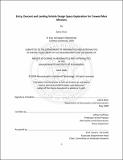| dc.contributor.advisor | Jeffrey Hoffman. | en_US |
| dc.contributor.author | Khan, Zahra | en_US |
| dc.contributor.other | Massachusetts Institute of Technology. Dept. of Aeronautics and Astronautics. | en_US |
| dc.date.accessioned | 2009-07-01T16:59:58Z | |
| dc.date.available | 2009-07-01T16:59:58Z | |
| dc.date.copyright | 2008 | en_US |
| dc.date.issued | 2008 | en_US |
| dc.identifier.uri | http://hdl.handle.net/1721.1/45300 | |
| dc.description | Thesis (S.M.)--Massachusetts Institute of Technology, Dept. of Aeronautics and Astronautics, 2008. | en_US |
| dc.description | This electronic version was submitted by the student author. The certified thesis is available in the Institute Archives and Special Collections. | en_US |
| dc.description | Includes bibliographical references (p. 76-77). | en_US |
| dc.description.abstract | With the announcement of the Vision for Space Exploration in 2004, NASA has been preparing plans for a crewed mission to Mars in the next few decades. One challenge associated with crewed missions to the Martian surface is the comparatively large mass of planned surface elements which will require an increase of at least an order of magnitude in the landed mass performance of entry, descent and landing (EDL) vehicles compared to previous successful robotic missions and ones currently planned for the near future. The work presented in this thesis attempts to look at the effect of individual vehicle and mission design parameters on the overall EDL system landed mass performance. For this purpose, a planetary EDL simulation and sensitivity analysis tool has been created which allows for the variation of a number of relevant parameters and provides the user with performance data. To date, the tool has been validated with experimental and simulated data for Mars missions. The tool assumes the use of propulsive means for final descent. Using this tool, a number of sensitivity analyses for different parameters for both the entry phase and the entire EDL profile have been conducted. Major insights gleaned from these include the need for research into propulsive descent safety requirements to prevent over-conservatism in establishing the propulsive descent initiation (PDI) altitude since a high PDI altitude can significantly lower EDL vehicle landed mass performance. Another area of research with the potential to provide significant improvements in performance is structural and thermal technology that reduces the aeroshell mass of the vehicle. Finally, the landed mass performance of a reference EDL vehicle with a spherical forebody and a conical aftbody was also evaluated. | en_US |
| dc.description.abstract | (cont.) For an entry mass of 62.5 mT (corresponding to a two Ares V launches), a moderate aeroshell mass fraction and a low-lying landing site, a significant payload of around 26 metric tons can be delivered to the Martian surface with two Ares V launches. This indicates that, from a landed mass perspective, a crewed Mars mission is feasible using the moderate lift reference vehicle, since the minimum landed mass requirements for such a mission are on the order of 20 to 30 metric tons. | en_US |
| dc.description.statementofresponsibility | by Zahra Khan. | en_US |
| dc.format.extent | 154 p. | en_US |
| dc.language.iso | eng | en_US |
| dc.publisher | Massachusetts Institute of Technology | en_US |
| dc.relation.requires | System requirements: Matlab version R2007a, CD-ROM drive. | en_US |
| dc.rights | M.I.T. theses are protected by
copyright. They may be viewed from this source for any purpose, but
reproduction or distribution in any format is prohibited without written
permission. See provided URL for inquiries about permission. | en_US |
| dc.rights.uri | http://dspace.mit.edu/handle/1721.1/7582 | en_US |
| dc.subject | Aeronautics and Astronautics. | en_US |
| dc.title | Entry, descent and landing vehicle design space exploration for crewed Mars missions | en_US |
| dc.type | Thesis | en_US |
| dc.description.degree | S.M. | en_US |
| dc.contributor.department | Massachusetts Institute of Technology. Department of Aeronautics and Astronautics | |
| dc.identifier.oclc | 312403635 | en_US |
